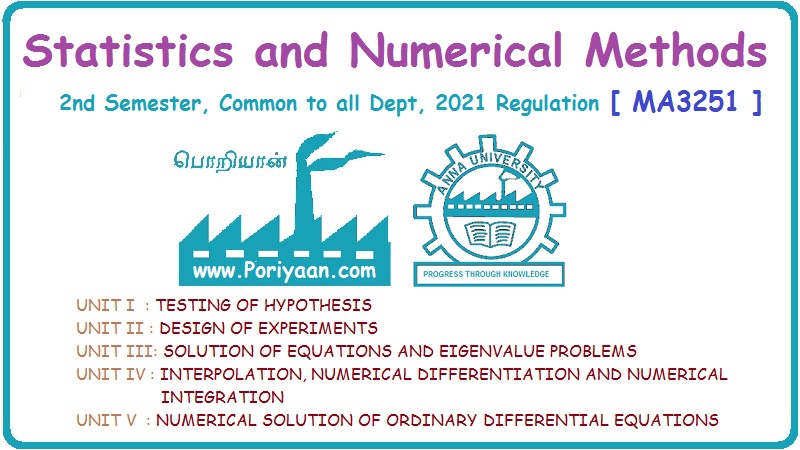Statistics and Numerical Methods: Unit IV: Interpolation, numerical differentiation and numerical integration
Exercise 4.5 (a) [Trapezoidal and Simpson's 1/3rd rule]
Solved Example Problems
Statistics and Numerical Methods : Unit - IV : Interpolation, numerical differentiation and numerical integration : Exercise 4.5 (a) [Trapezoidal and Simpson's 1/3rd rule]
EXERCISE 4.5 (a) [Trapezoidal and Simpson's 1/3rd rule]
1.
Compute the value of  using Simpson's rule and Trapezoidal rule.
using Simpson's rule and Trapezoidal rule.
Take
h = 0.25.
[Ans. 0.6931, 0.6971]
2.
Evaluate  correct to two decimal places, using seven ordinates.
correct to two decimal places, using seven ordinates.
[Ans. 1.3935]
3.
Find the value of  using Simpson's one-third rule with h = 0.025
using Simpson's one-third rule with h = 0.025
[Ans.
0.23108]
4.
The velocity v of a particle at distance s from a point on its path is given by
the table below.

Estimate
the time taken to travel 60 metres by using Simpson's one-third rule.

[Ans. 1.0635 sec]
5. When a train is moving at 30 m/sec. steam is shut off and brakes are applied. The speed of the train per second after t seconds is given by

[Ans. 606.66 mm]
6.
Evaluate  to three decimals, dividing the range of integration
into 8 equal parts using Simpson's rule.
to three decimals, dividing the range of integration
into 8 equal parts using Simpson's rule.
[Ans.
0.8145]
7.
A solid of revolution is formed by rotating about the X-axis, the area between
X-axis, x = 0, x = 1 and the curve through the points (0, 1), (0.25, 0.9896),
(0.5, 0.9589), (0.75, 0.9089) and (1, 0.8415). Find the volume of solid.
[Ans.
2.819]
8.
Given e0 = 1, e1 = 2.72, e2 = 7.39, e3 =
20.09, e4 = 54.60, use Simpson's rule to evaluate  Compare your result with exact value.
Compare your result with exact value.
[Ans.
53.8733, 53.598]
9.
Evaluate,  dx by taking h = 0.1 using Simpson's rule.
dx by taking h = 0.1 using Simpson's rule.
[Ans. 0.972]
10.
Evaluate,  dx by dividing the range into 8 equal parts.
dx by dividing the range into 8 equal parts.
[Ans.
1.299]
11.
Calculate,  taking h = π / 6
taking h = π / 6
[Ans. 1.305]
12.
The velocity v of a particle moving in a straight line covers a distance x in
time t. They are related as follows :

Find
time taken to traverse the distance of 40 units.
[Ans.
0.725 units of time]
13.
Evaluate,  h = 0.05 by various
methods. What is the error made in using Trapezoidal rule.
h = 0.05 by various
methods. What is the error made in using Trapezoidal rule.
[Ans.
0.32147, 0.32149, error = 0.00002]
14.
Calculate,  taking 5
ordinates by Simpson's rule.
taking 5
ordinates by Simpson's rule.
[Ans. 0.08409]
15.
A river is 40 m wide. The depth d in metres at a distance x metres So from one
bank is given by the table below:

Find
the cross-section of the river by Simpson's rule.
[Ans.
190 sq.m]
16.
The speed of a train at various times are given by

Find
the total distance covered.
[Ans.
1.6666 km]
17.
A reservoir discharging water through sluices has a depth h metre below the
water surface, has a surface area A for various values of h as given below:

If
t denotes time in minutes, the rate of fall of surface area is given by dh / dt
= 48 √h / A. Estimate the time taken for the water level to fall from 14 to 10
metres above the sluices.
[Ans.
29 minutes nearly]
18.
Evaluate  Simpson's (1/3) rule, dividing the range into four equal
parts. [A.U M/J 2016 R13]
Simpson's (1/3) rule, dividing the range into four equal
parts. [A.U M/J 2016 R13]
[Ans.
0.7854]
Statistics and Numerical Methods: Unit IV: Interpolation, numerical differentiation and numerical integration : Tag: : Solved Example Problems - Exercise 4.5 (a) [Trapezoidal and Simpson's 1/3rd rule]
Related Topics
Related Subjects
Statistics and Numerical Methods
MA3251 2nd Semester 2021 Regulation M2 Engineering Mathematics 2 | 2nd Semester Common to all Dept 2021 Regulation
